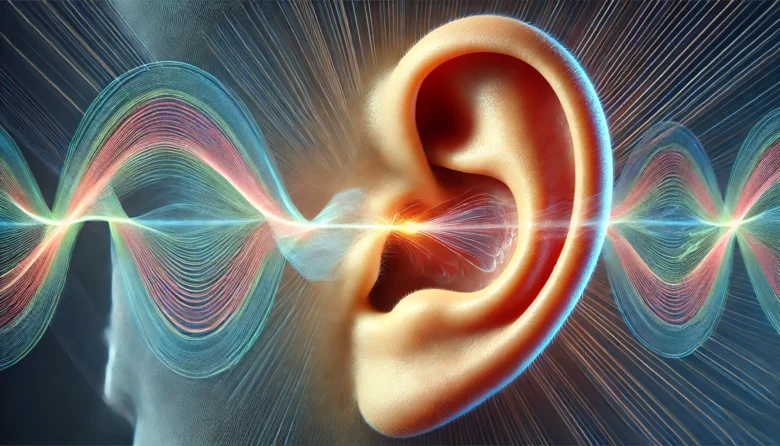Have you ever wondered how we could hear the rustle of leaves, the hum of a car engine, or our favourite songs? The journey of sound from the environment to our brains is a fascinating one, filled with incredible physics and biology. In this blog, we’ll explore “The Physics of Sound: How We Hear” and dive into the mechanics behind this everyday phenomenon. From how sound waves travel to how our ears convert them into signals that the brain can interpret, this blog will break it down in a way that’s easy to understand and relatable.
What is Sound?
Sound is a type of energy that travels in waves. These waves are created when an object vibrates, causing the surrounding air molecules to move. These movements create pressure variations—essentially compressions and rarefactions—that travel through the air as sound waves.
Imagine plucking the string of a guitar. When you do, the string vibrates, causing the surrounding air to move, which produces a wave that eventually reaches your ear. That’s how you hear the sound of the guitar! But the process of how we hear involves more than just the sound waves reaching our ears.

How Do Sound Waves Travel?
Sound travels through different mediums—like air, water, and even solids. In the air, sound waves are carried as longitudinal waves, meaning the air molecules move in the same direction as the wave is travelling. This is different from how light waves, which are transverse, travel.
Interestingly, sound moves faster through denser materials. In water, for instance, sound travels about four times faster than in air! This is why underwater communication is different and why sound underwater can seem muffled or distorted to us when we swim.
For a more everyday example, think about how you can hear a train coming from far away if you put your ear to the ground. The ground is a much denser medium, allowing sound waves to travel faster through it than through the air.
The Journey of Sound in Our Ears
The real magic begins when sound waves reach your ears. The ear is divided into three parts: the outer ear, the middle ear, and the inner ear, each playing a critical role in how we perceive sound.
The Outer Ear: The visible part of your ear, known as the pinna, funnels sound waves into the ear canal, directing them toward the eardrum.
The Middle Ear: The sound waves make contact with the eardrum, causing it to vibrate in response. These vibrations are passed on to three tiny bones in the middle ear—the malleus (hammer), incus (anvil), and stapes (stirrup)—collectively known as the ossicles. These bones amplify the sound vibrations and send them to the inner ear.
The Inner Ear: This is where, the vibrations are transformed into signals that the brain can interpret. Inside the inner ear is a fluid-filled structure known as the cochlea, which has a spiral shape resembling a snail. Inside the cochlea are thousands of tiny hair cells. As the vibrations pass through the fluid in the cochlea, tiny hair cells are stimulated, generating electrical signals that are sent to the brain via the auditory nerve.
The brain then processes these signals and interprets them as the sounds we recognize, from a baby’s cry to the melody of your favourite song.
Frequency and Pitch: Why Some Sounds Are High and Others Are Low
Sound waves come in different frequencies. A frequency is the number of waves that pass a point in one second, and it’s measured in Hertz (Hz). High-frequency sounds have short wavelengths and create high-pitched sounds, while low-frequency sounds have longer wavelengths and produce low-pitched sounds.
For example, a bird’s chirp is a high-frequency sound, while the deep rumble of thunder is a low-frequency sound. Human ears are designed to hear a range of frequencies, typically between 20 Hz and 20,000 Hz. Dogs, on the other hand, can hear frequencies that are much higher than humans, which is why they respond to dog whistles that we can’t hear.
Loudness: How Do We Perceive Volume?
The amplitude of a sound wave determines how loud or soft the sound is. The greater the amplitude, the louder the sound. Amplitude is measured in decibels (dB). For example, everyday conversation typically measures around 60 dB, whereas the sound at a rock concert can go up to approximately 120 dB. Prolonged exposure to loud sounds can damage the hair cells in the cochlea, leading to hearing loss.
Anecdotally, this is why your parents may have warned you about listening to loud music with headphones on—it’s true! Over time, those hair cells can get damaged, and unlike many other cells in our body, they don’t regenerate.
Case Study: The Doppler Effect
Have you ever noticed that a passing ambulance siren changes pitch as it moves by? This is called the Doppler Effect, which occurs because sound waves compress as the source moves closer to you and stretch out as it moves away. When the ambulance is moving towards you, the sound waves are shorter, and you hear a higher pitch. As it moves away, the waves stretch out, and you hear a lower pitch.
This effect is a perfect example of how physics governs our perception of sound in real life, showing us that sound is more than just waves in the air—it’s a dynamic experience affected by motion, distance, and even the medium through which it travels.
Conclusion
The journey of sound, from the vibration of an object to the intricate workings of our ears, is a wonder of both physics and biology. Understanding “The Physics of Sound: How We Hear” not only helps us appreciate the sounds around us but also sheds light on how delicate and finely tuned our hearing system is.
Next time you listen to your favourite song, pause for a moment to think about how many tiny steps are involved in making that experience possible. It’s an awe-inspiring process that brings a deeper connection to the world around us.
Author’s Note
Thank you for diving into the fascinating world of sound with me! Whether it’s the chirping of birds or the crash of ocean waves, sound is all around us, shaping how we experience life. I hope this article helped demystify the physics behind how we hear. Stay curious and keep exploring!
G.C., Ecosociosphere contributor.
References and Further Reading
- How Do We Hear?
- Vibration, Sound Waves, and STEM Project – Cool School Comics. https://coolschoolcomics.com/vibration-sound-waves-and-stem-project/
- Bryant, J. W. (2007). Sound, Awareness and Place: Architecture from an Aural Perspective. https://core.ac.uk/download/56104456.pdf
- How Many Decibels Before Hearing Loss – HealthyHearingClub.net. https://www.healthyhearingclub.net/how-many-decibels-before-hearing-loss/
- How Do Sounds Travel Through Air? – greentravelguides.tv. https://greentravelguides.tv/how-do-sounds-travel-through-air/
- How Does Loud Noise Cause Ear Damage? | Today’s Hearing | Blog. https://tohear.com/how-does-loud-noise-cause-ear-damage/
- What You Need to Know About Your Ears and Hearing Loss – DIY in Real Life. https://www.diyinreallife.com/how-auditory-system-works/
- The Healing effect of sound waves. https://www.soundwheel.com/post/the-healing-effect-of-sound-waves
- How Do Sound Waves Form and Travel? – greentravelguides.tv. https://greentravelguides.tv/how-do-sound-waves-form-and-travel/
- New study shows teens at risk for hearing loss. https://www.mpnnow.com/story/news/2010/09/29/new-study-shows-teens-at/45585291007/





Comments
I just like the helpful information you provide in your articles
Rattling nice design and excellent subject matter, hardly anything else we want : D.